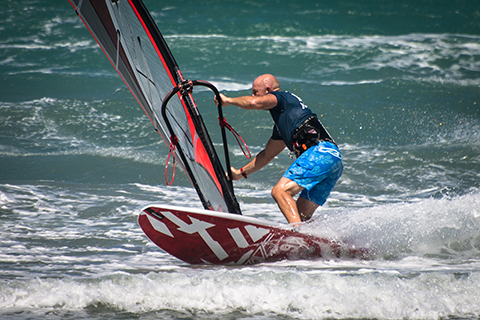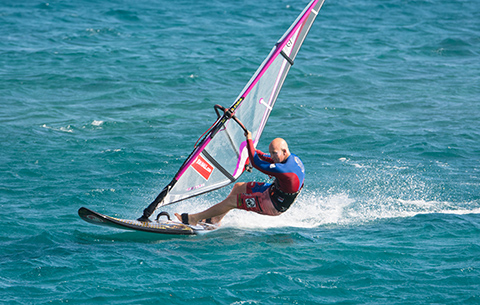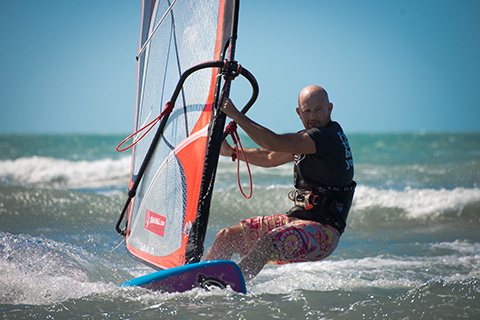JEM HALL
MOVE ON UP – WINDSURFING TECHNIQUE
THE MOVES THAT MATTER
For many people April is the month we dust off the kit and look to get out on the water again and perhaps with some new targets in tow. With this in mind, I will give you some food for thought and clarify the ‘Moves that matter’ and how to improve in these at all levels.
Words Jem Hall // Photo Nicolas Jones & Sue Winston
www.jemhall.com
(This feature originally appeared in the April 2016 issue of Windsurf Magazine. To read more features like this first, Print and Digital subscriptions are available. Prices include delivery globally for 10 x issues a year!)
I have had this subject in mind for a long time as people often ask me what they should be learning and aspiring to. On my coaching clinics I witness first hand what my rippers benefit from working on. Often enquiries for my clinics say words to the effect of ‘I would like to learn the carve gybe, and we can work on the Vulcan and forward too,’ and yes all in the same week! Well we can all have dreams and aspirations, but it is best for our targets to be realistic and achievable, hence why I will always suggest investing in learning forward loops over back loops in the rotational jumps section of the Moves that Matter for example.
THE WISH LIST
1) Holy trinity: Having these skills down really will be the gift that keeps on giving throughout all our windsurfing. Namely the ability to plane (preferably early), sail fast and stay upwind. People come on wave clinics and think I will concentrate on loops and riding and yet we still address these, a lot! And Improvers really need to pin these down to move through this list and more advanced moves.
2) Tacking: This really is the building block of all transitions, if you can tack well you will learn to gybe faster and also rip in the waves too. It teaches you so much about your vision, body position and how to move your dancing feet. Use it or lose it, from light winds through to fully planing carve tacks. 3) Super Starts: Learning to beach start badly will stunt your growth in waterstarts, so get these right and you will fly down this list. Your beach and waterstart tells me a huge amount about how you windsurf, if you get it you understand all about the 2 key actions of bending the back leg and pulling down on the boom! As starts progress, keep improving them and make them faster.
4) Gybing: Time well spent on light wind gybes as an improver will ease your progress in the carve gybe. As you advance if you rip in the gybe you will learn to wave ride really fast. Set high standards here and this will define you as a windsurfer!
5) Jumping: Shock horror why is this so early in the list? Well, I don’t want you resting in your comfort zone and I want you to have some fun and get comfy with a few crashes and also enjoy the freedom of flight. People really do leave learning this till way too late in the sport.
6) Duck gybing: Learn it in light winds and do it when planing as soon as you are getting round a fair few carve gybes. Again, it is fun and a bit risky and promotes good rig handling skills.
7) Carving freestyle: Cracking a move like the Carve 360 in the straps will really get you excited and is a great builder of skills and helps you fully understand how to carve.
8) Rotational jump: Go on, you know you want to and so many more of you are, hoorah! When I learnt to forward loop I felt like I could learn any move and it is a great gateway to further progression.
9) Aerial freestyle: This will keep you sane on flat water, and in medium winds, while teaching great board control and adding a new dimension to enjoying all aspects of our great sport. We are talking vulcans, grubbies, aerial gybes, willy skippers and so on.
10) Waveriding: For me, and many of you, this is the absolute pinnacle of our sport and test in technique. All the moves in this list build us to move on up in this one move that really matters.
This month I will focus next on the first five in the list and in part two, next issue, we will finish off educating you on all the moves. Remember this list is to target your improvement work into key areas that will help you progress in your windsurfing.
For a more detailed look at some of the skills in this list check the windsurf.co.uk archives of my prior articles / back issues for a more thorough breakdown of tips, skills and drills.
“ Your beach and waterstart tells me a huge amount about how you windsurf ’’

// Drive in your Gybe with your rig forward and back hand way back and then fight to plane out of your exits. PHOTO Sue Winston
SKILLS AND DRILLS TO BELIEVE AND ACHIEVE
Discovering the Holy trinity
Plane, sail fast and stay upwind – these three basic and all encompassing skills can be improved by all levels with subtle changes: getting lower, positioning your hands more effectively i.e., in more proximity to the front harness line, looking more in the direction of where the wind is coming from and where you want to go. This sounds simple yet we all fail in this, so let’s up our game.
Specific targets for the different levels are:
Improvers: sail with your hands closer together, lift one hand off the boom hooked in and unhooked and really crack chugging upwind (sinking the rail to get upwind whilst non-planing).
Intermediates: Spot lulls and hit them with your arms extended and toes down, sail upwind one handed and race people safely in clean wind.
Advanced: Get planing in straps without hooking in, take a cruise a few km’s upwind, strap on the GPS and check your top speed or enlist in some national racing or the NWF!
Topping the Tacking
We learn this move to ‘turn round’ when we are beginners and perhaps don’t give it the respect it deserves. Upping your game in the tack will keep you safe, get you upwind and planing tacks get big respect.
Specific targets for the different levels are:
Improvers: appreciate the power of scissoring your legs in and out of the move, keep your straight line speed into the move and prepare with your hand on the mast without the sail sheeting out.
Intermediates: Embrace the tack preparation battle cry of H.U.F. (Hand, Unhook, Footstraps) with aplomb by moving your front hand, unhooking and coming out of the straps all without losing too much speed and get round the mast with a slick pivot.
Advanced: Moving your tacking competency and consistency down to sub 90 litre boards and really aim to exit your tack straight into the front footstrap to aid planing out of them.
Put the super in your beach and water starts
Saving energy and being efficient here means you can use more energy for the tougher moves and also that you can sail in more challenging conditions
Specific targets for the different levels are:
Improvers: Nail this both ways ASAP, and ensure you are very good at steering the board in the ready position and whilst flipping the sail too.
Intermediates: Speed up your rig recoveries in all board and rig positions; learn to do the light wind waterstart with your front hand on the mast.
Advanced: Be able to get out of the water in 7 knots, have the clew first waterstart in your armoury and yes, in both ways.

// Sail fast, by getting low and dropping your arse and elbows. PHOTO Nicolas Jones
Putting the carve into your gybing
A gateway move and the move that can be a beauty but also a beast.
Specific targets for the different levels are:
Improvers: Understand the power of scissoring and steering with your legs, fully embrace getting your hand way down the boom, and develop your clew first exits.
Intermediates: Unhook and scissor the board downwind and really look to accelerate into the move, feel the connection as you look out of the turn (at the clew) in your mid gybe, and rotate the rig without looking at it.
Advanced: Roll into your gybe as you get the rig forward, carve out of your gybe, aim to plane out and really fight for this!
Find joy in your jumping
Specific targets for the different levels are:
Improvers: Get to the rear of the board and learn to sink the tail and then recover it, this will teach you to open the sail and push down on the tail in readiness to do exactly this in your future. Do some leg drags to build fitness and discover how mast foot pressure works and that pulling your heel in keeps the tail close, in readiness for jumping and recovery skills.
Intermediates: When about to jump ensure you change position by unhooking and getting over the board, this will aid sinking the tail / sending the nose to the sky; understand you have to lift the board out of the water with your legs (and arms) and therefore aiming to bring your front knee to your chin.
Advanced: Ensure you can chop hop/jump both ways, i.e port and starboard, even when the ramps in your future.in-flight control get yourself compact and outboard in the air with your back leg bringing the tail up. Learn to do a one handed jump, front hand or back off as this will build subtle aerial trim skills, and both feels and looks great.
Know your targets and a great tip to ensure you do them is writing them on the back of your hand. You must want to improve and to do this, have and know your own specific plan of attack to crack the moves on this list.
As the saying goes “If you always do what you have always done, you will always get what you always got.”
“ Know your targets and a great tip to ensure you do them is write them on the back of your hand ’’

// If you look out the turn, keeping low and out then you can carve OUT of your gybes. PHOTO Brett Kenny

// Develop all your starts – pull down on your front arm and really bend that back leg. PHOTO Nicolas Jones
RRD boards, wetsuits, softwear, Ezzy sails and Pro Sport Sunblock sponsor Jem Hall. Get him live and direct on one of his highly acclaimed coaching holidays. You can also follow him on twitter / Facebook and Instagram.
www.jemhall.com


